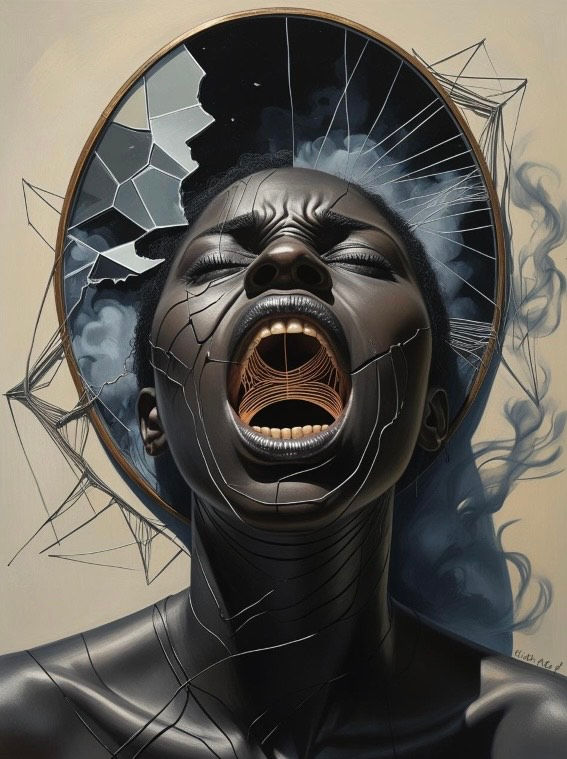Fragments to Wholeness
- Elinth Arts
- Sep 25
- 4 min read
Visual artist, Elinth Arts, uses art to challenge stigma, advocate for mental health, and inspire communities to embrace healing through creativity.
Interview with Elinth Arts
1. Please tell us something about your background and your art journey so far.
My name is Olubunmi Elizabeth Ebisemiju, and I create under my artist brand Elinth Arts. I began my creative journey as a unisex fashion designer in Nigeria in 2010 where I spent over a decade creating bespoke pieces that explored bespoke identity and storytelling through my fashion sketches and apparel production. But life took an unexpected turn. Relocating to the UK, going through a divorce, domestic violence, and eventually suffering a heart attack pulled me away from fashion. In that broken space, I turned to abstract drawing — first as a distraction, source of therapeutic expression and survival mechanism, then as my new language. My recent collection, Fragments to Wholeness, was born from this period. It charts my mental health struggles and eventual recovery, transforming my personal pain into a universal story of resilience and hope.

2. Describe what a normal day looks like as an artist.
No two days are ever exactly alike, but my days usually begin with silence — journaling, prayer, school runs and sketching (if time allows) before the world intrudes. Sometimes I work on a single drawing for hours, layering pencil marks that mirror the layers of human experience. Other days are more administrative: writing exhibition proposals, answering emails, or mentoring SMEs in my consultancy practice. I try to live in balance: some time for art, some time for advocacy, some time for business and other times for self care.
3. Can you tell us more about the theme in your art and your inspiration?
The core theme of my art is healing through creativity. My works are mostly abstract but deeply personal — they speak about domestic violence, emotional breakdown, silence, therapy, resilience, and restoration. Yet, they are not only about me; they mirror the hidden struggles many carry. I am inspired by cracks, fragments, and the Japanese concept of kintsugi — that brokenness can be mended into something more beautiful. My art explores how the very fragments of our lives can become the materials of wholeness.
4. How does your art life impact other parts of your life?
Art has become my medicine, my teacher, and my advocate. Creating gives me clarity in my business consulting work, compassion in my mental health advocacy, and confidence in public speaking. It has also given me community — people connect with my art in ways words cannot, and that connection spills over into real collaborations and healing conversations.

5. Could you share any difficulties and hardships you had to face in life and how or if you managed/overcame them?
I’ve lived through domestic violence, depression, divorce, financial instability, and health breakdowns. At one point, I wondered if life was worth fighting for. What saved me was the combination of therapy, faith, creativity, and community. Therapy helped me confront pain, art gave me a voice, faith gave me strength, and community reminded me I wasn’t alone. Today, my hardships are the soil from which my advocacy grows.
6. Tell us about your best experience in the art world so far.
One of my best experiences was when people first engaged with the earlier pieces from my collection “Fragments to Wholeness” at exhibitions/art fairs last year. Viewers shared how a single piece mirrored their own silent battles. Some cried, some felt relief, some simply said, “Thank you for saying what I couldn’t.” I still get similar comments till date, That, to me, is art at its best — when it stops being mine and becomes ours.

7. Share your worst experience in the art world.
As a woman rebuilding her career in a new country, my worst experience has been encountering gatekeeping. Being told that my work didn’t “fit” certain categories, or not being taken seriously because I was new, female, or an immigrant. Those moments stung, but they also fueled my determination to carve out my own space and build institutions where other marginalized voices will never be silenced.
8. What practical advice can you give to fellow artists?
Own your story. No matter how fragmented it feels, it’s your greatest asset.
Balance creativity with strategy. Talent opens the door, but consistency and professionalism keep it open.
Collaborate. Don’t walk alone; the art world is stronger when we lift each other.
Protect your wellbeing. Your creativity flows best from a cared-for mind and body.
9. Is the artist life lonely? Please share your thoughts and experiences.
It can be. Long hours in the studio, navigating rejection, or struggling financially can feel isolating. But I’ve learned that loneliness shifts when art becomes a bridge. Every time someone tells me they “see themselves” in my work, I realize that we are never truly alone — we’re all just waiting for connection. Also, having friends who are artists has made conversations around art and life flow even better.
10. What are you working on at the moment and are there any upcoming events you would like to talk about?
Right now, I am working on another collection that explores the depth of art therapy for mentally/emotionally challenged individuals through abstract concepts that provokes curiosity, connection, insight and healing. I am also preparing for two major events in Manchester this October:
“Fragments to Wholeness” – Solo Exhibition at Chuck Gallery
“Threads of Us” – A public live art performance which has received many positive collaboration requests, a key one by my Alma mater, University of Law in celebration of World Mental Health Day on the 10th October 2025.
Both events are centered on mental health awareness and creativity as healing. Beyond these, my bigger vision is to establish a cultural institution where art and wellbeing meet.
Website : https://elintharts.mypixieset.com/
TikTok : @elintharts








